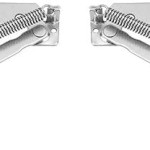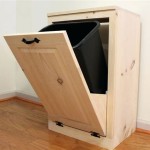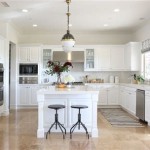Kitchen Floors With Dark Cabinets: A Comprehensive Guide
The selection of kitchen flooring when paired with dark cabinets is a crucial design decision that significantly impacts the overall aesthetic and functionality of the space. Dark cabinets, whether stained wood, painted surfaces, or laminate, anchor the kitchen with a sense of sophistication and depth. However, their inherent darkness can also make a kitchen feel smaller or less inviting if not balanced correctly with appropriate flooring.
Therefore, careful consideration must be given to the flooring material, color, pattern, and texture to achieve a harmonious and visually appealing kitchen design. The goal is to create a space that is both stylish and practical, meeting the demands of daily use while reflecting the homeowner's personal taste. This guide explores various flooring options and design considerations for kitchens featuring dark cabinets, providing information to inform informed decision-making.
Understanding the Impact of Color and Tone
The interaction of color between dark cabinets and flooring is paramount in determining the overall ambiance of the kitchen. Dark cabinets inherently absorb light, making it vital to select flooring that either reflects light to brighten the space or complements the darkness in a visually interesting way. The color palette chosen should aim to create balance and prevent the kitchen from feeling cramped or gloomy.
Light-colored flooring options, such as white, cream, or light gray, are effective in reflecting light and creating a sense of spaciousness. These colors provide a stark contrast against dark cabinets, highlighting their features and creating a clean, modern look. Conversely, darker flooring options, such as dark gray, brown, or even black, can create a more dramatic and cohesive look, especially when paired with lighter countertops and backsplashes to provide visual contrast.
The undertones of both the cabinets and the flooring should also be considered. Cool undertones in dark cabinets might pair well with cool-toned gray or blueish flooring, while warm undertones would benefit from warmer beige or brown tones. Ignoring these subtle nuances can result in a clash of colors that detracts from the overall design.
Beyond solid colors, patterned flooring can add visual interest and break up the monotony of dark cabinets. Geometric patterns, herringbone designs, or even subtle textures can introduce depth and complexity to the space. However, it is important to ensure that the pattern is not too busy or overwhelming, as it can compete with the dark cabinets for attention.
Exploring Flooring Materials and Their Suitability
The choice of flooring material is not solely based on aesthetics; durability, maintenance, and cost are also significant factors. Each flooring material possesses unique characteristics that make it more or less suitable for a kitchen environment.
Hardwood: A classic choice, hardwood flooring adds warmth and elegance to any kitchen. Light-colored or medium-toned hardwoods, such as oak, maple, or birch, provide a beautiful contrast against dark cabinets. Hardwood is durable and can be refinished to extend its lifespan. However, it is susceptible to moisture damage and requires regular maintenance, including sealing and cleaning with appropriate products. Engineered hardwood offers a more moisture-resistant alternative to solid hardwood, making it a suitable option for kitchens with moderate humidity levels.
Tile: Tile is a highly durable and water-resistant flooring option that is well-suited for kitchens. Porcelain and ceramic tiles are available in a wide range of colors, patterns, and sizes, offering numerous design possibilities. Light-colored tiles, such as white, beige, or light gray, can effectively brighten the space and complement dark cabinets. Patterned tiles can add visual interest, while larger tiles can create a more seamless and spacious look. Grout lines should be sealed regularly to prevent staining and maintain the tile's appearance.
Vinyl: Vinyl flooring, particularly luxury vinyl planks (LVP) and luxury vinyl tiles (LVT), has become increasingly popular due to its durability, water resistance, and affordability. Vinyl flooring is available in a variety of styles that mimic the look of hardwood, tile, and stone. Light-colored or wood-look vinyl flooring can provide a warm and inviting contrast against dark cabinets. Vinyl is also relatively easy to install and maintain, making it a practical choice for busy kitchens.
Laminate: Laminate flooring is another affordable and durable option that can mimic the look of hardwood or tile. While laminate is less water-resistant than vinyl or tile, it is still suitable for kitchens with proper care. Light-colored laminate flooring can create a bright and airy feel when paired with dark cabinets. Laminate flooring is easy to clean and maintain, but it is important to protect it from excessive moisture to prevent swelling and damage.
Concrete: Concrete flooring offers a modern and industrial aesthetic that can complement dark cabinets. Concrete can be stained, polished, or sealed to achieve a variety of looks. Light-colored or polished concrete can reflect light and brighten the space, while darker stains can create a more dramatic effect. Concrete is durable and easy to maintain, but it can be cold and hard underfoot. Area rugs can be used to add warmth and comfort.
Considering Design Styles and Practical Considerations
The selection of kitchen flooring should also align with the overall design style of the home. A modern kitchen might benefit from sleek and minimalist flooring options, while a traditional kitchen might call for more classic and elegant choices.
In a modern kitchen, light gray or white tile, polished concrete, or light-colored vinyl flooring can create a clean and contemporary look when paired with dark cabinets. Simple geometric patterns or subtle textures can add visual interest without overwhelming the space. Minimalist hardware and streamlined appliances can further enhance the modern aesthetic.
For a traditional kitchen, hardwood flooring in a light to medium tone can create a warm and inviting atmosphere. Ceramic tiles with classic patterns or natural stone tiles can also complement dark cabinets. Traditional hardware and decorative details can add to the overall charm of the space.
A farmhouse style kitchen might incorporate light-colored wood-look vinyl or laminate flooring to create a rustic and comfortable feel. Distressed finishes and natural textures can further enhance the farmhouse aesthetic. Open shelving and vintage-inspired accessories can add character and personality.
Beyond aesthetics, practical considerations should also influence the choice of flooring. The level of foot traffic in the kitchen, the presence of pets or children, and the potential for spills and stains should all be taken into account. Durable and easy-to-clean flooring options are particularly important in high-traffic kitchens. Water-resistant materials are also essential in areas prone to spills and moisture.
The size of the kitchen should also be considered when selecting flooring. In smaller kitchens, lighter flooring options can help to create a sense of spaciousness. Larger tiles or planks can also visually expand the space. In larger kitchens, darker flooring options can be used to create a more dramatic and intimate feel. Area rugs can be used to define different zones within the kitchen and add warmth and comfort. Properly sealing and maintaining the chosen flooring material is crucial to its longevity and appearance.
Lighting within the kitchen will also impact the appearance of the flooring. Natural light will accentuate the true color and texture of the floor, while artificial lighting can alter its appearance. Consider the type of lighting used in the kitchen and how it will interact with the flooring material. Under-cabinet lighting can also be used to highlight the flooring and create a more inviting ambiance.
Finally, the overall budget for the kitchen renovation should be considered when selecting flooring. Different flooring materials vary significantly in price, and installation costs can also vary depending on the material and the complexity of the installation. It is important to establish a budget upfront and choose flooring that aligns with both the aesthetic goals and the financial constraints.

17 Flooring Options For Dark Kitchen Cabinets

Flooring Ideas For Dark Kitchen Cabinets Wren Kitchens
Dark Wood Cabinets With Light Floors Kitchen Interior Design Pa

What Color Wood Floors Go With Dark Cabinets Chestnut Flooring

31 Best Kitchens With Dark Cabinets Wood Floors Ideas Kitchen Design Remodel New

Flooring Ideas For Dark Kitchen Cabinets Wren Kitchens

Premium Photo Kitchen In A New Luxury Home Hardwood Floors Dark Cabinets

Ways To Incorporate Dark Stained Cabinets Into Your Kitchen

23 Classy Projects With Dark Kitchen Cabinets

75 Marble Floor Kitchen With Dark Wood Cabinets Ideas You Ll Love November 2024 Houzz








